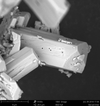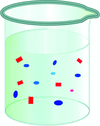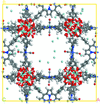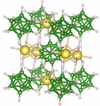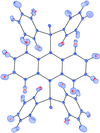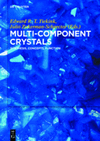issue contents
June 2019 issue

Cover illustration: Under high pressure, Ar and Ne interact with CH3NH3PbI3, but in different ways. Maybe this organic–inorganic perovskite is a suitable laboratory for studying the chemistry of noble gases, see A. Arakcheeva et al. [(2019). Acta Cryst. B75, 361–370].
scientific comment
The article points to the fact that there are examples of degenerate chemical reactions which occur in crystals. Such reactions are concomitant with the order–disorder phase transitions or with domain reorientations in some ferroelastic crystals. The latter case is discussed here.
research papers
Download citation


Download citation


A fourth polymorph of the double carbonate BaCa(CO3)2 has been found and it is demonstrated that this polymorph can be synthesized via three different synthesis routes. The structure was solved by a combination of density-functional-theory-based model calculations and Rietveld refinement.
CCDC reference: 1901527
The interactions of nucleic acid bases with non-coordinated and coordinated water molecules were studied by analyzing data in the Protein Data Bank (PDB) and by quantum chemical calculations. The calculated interaction energies for [Mg(H2O)6]2+–nucleic acid base systems are from −12.94 to −49.96 kcal mol−1, for [Na(H2O)6]+–nucleic acid base systems they are from −6.66 kcal mol−1 to −19.63 kcal mol−1, while for non-coordinated water–nucleic acid base they are from −4.63 to −8.93 kcal mol−1, which is similar to the strength of hydrogen bonds between nucleic acid bases calculated previously.
Intermolecular interactions of 2,4,6,8,10,12-hexanitrohexaazaisowurtzitane–dinitrobenzene (CL-20–DNB) and CL-20–2,4,6-trinitrotoluene (TNT) cocrystals are analyzed and a novel energetic–energetic cocrystal of CL-20–2,4,6-trinitrophenol (TNP) is designed. The crystal structures and formation mechanism of the novel kinetic CL-20–TNP cocrystal are also analyzed.
A temperature-dependent cobalt(II) porphyrin complex within a metal–organic framework is investigated, showing six- and five-coordinated models for low- and high-temperature systems, respectively.
Crystal structures of the iron face-centered cubic modification (austenite) and Fe3C carbide can be transformed into each other by diagonal flipping in a rhombus consisting of two adjacent triangular faces. This transformation mechanism determines the orientation relationship between austenite and Fe3C carbide which has been observed in many experiments.
Download citation


Download citation


The microstructure of zeolite IM-18 with correlated disorder was elucidated by simulating the diffuse scattering of powder and single-crystal diffraction patterns. The method could be applied to other multidimensional disordered structures.
CCDC reference: 1857218
Download citation


Download citation


A series of high-pressure structure determinations using single-crystal X-ray diffraction experiments was performed for pyrene-1-carbaldehyde, a relatively simple organic compound, highly luminescent in the solid state and crystallizing in a challenging low-symmetry system. X-ray structure determinations were conducted using a multi-crystal approach. Piezochromic properties of pyrene-1-carbaldehyde were studied with UV–vis spectroscopy and periodic DFT calculations.
This work focuses on a new ![[R{\bar 3}c]](/b/issues/2019/03/00/um5027/teximages/um5027fi1.gif) phase material, AgCuF3, which has a combination of multiple Dirac cones and 100% spin polarization properties. Compared to the non-spin polarization system LaCuO3, the spin-polarized Dirac behavior in AgCuF3 is intrinsic and does not need the help of additional experimental conditions.
phase material, AgCuF3, which has a combination of multiple Dirac cones and 100% spin polarization properties. Compared to the non-spin polarization system LaCuO3, the spin-polarized Dirac behavior in AgCuF3 is intrinsic and does not need the help of additional experimental conditions.
![[R{\bar 3}c]](/b/issues/2019/03/00/um5027/teximages/um5027fi1.gif) phase material, AgCuF3, which has a combination of multiple Dirac cones and 100% spin polarization properties. Compared to the non-spin polarization system LaCuO3, the spin-polarized Dirac behavior in AgCuF3 is intrinsic and does not need the help of additional experimental conditions.
phase material, AgCuF3, which has a combination of multiple Dirac cones and 100% spin polarization properties. Compared to the non-spin polarization system LaCuO3, the spin-polarized Dirac behavior in AgCuF3 is intrinsic and does not need the help of additional experimental conditions. Download citation


Download citation


Open  access
access
 access
accessPressure-induced transformation of CH3NH3PbI3: the role of the noble-gas pressure transmitting media
A structural study of methylammonium lead triiodide [CH3NH3PbI3 (MAPbI3)], at high pressures up to 20 GPa using noble gases Ne and Ar as pressure-transmitting media is reported. It is found that both noble gases are chemically active at high pressures. In particular, Ne stabilizes the high-pressure structure of NexMAPbI3 and prevents amorphization up to 20 GPa. In contrast, Ar acts as a stabilizer only up to 2.4 GPa and accelerates irreversible amorphization upon further compression.
With the aim of finding new cocrystals, a network of coformers is constructed using the data present in the Cambridge Structural Database. The network is analyzed in terms of coformer clustering, popularity and network type, providing new data-driven insights into cocrystallization.
Download citation


Download citation


The crystal structures of two polymorphs of cis-perinone derive from stacking of flat molecules arranged due to π–π interactions. The difference in direct current electric conductivity of the materials could be explained by the dependence of the mobility and concentration of charge carriers on the structure.
It is shown how Monte Carlo methods can be used to analyse the observed diffuse scattering and yield an unprecedented and informative structural model of an intermediate step in the transition between the two end structures, α and β, of DL-norleucine.
Download citation


Download citation


Herein is described the two pressure-induced phase transitions of sodium dodecahydro-closo-dodecaborate (Na2B12H12), a candidate for a solid-state electrolyte.
CHEMISTRY | CRYSTENG
Download citation


Download citation


Open  access
access
 access
accessA very rare example of a diketopyrrolopyrrole derivative showing polymorphism with completely different molecular conformations and a different arrangement of neighbouring molecules is reported. The thermodynamic stability relationships between the three polymorphic forms are also interpreted.
CCDC reference: 1880254
This article describes a recent advance in the CrystalPredictor code for crystal structure prediction, namely a smoothed intramolecular potential, that improves the accuracy and efficiency of calculations, allowing for investigations into larger and more flexible molecules. It is illustrated with four case studies into large flexible molecules: ROY, glucose, molecule (XXVI) and flufenamic acid.
Download citation


Download citation


Five different methods for approximation of hydrogen-atom parameters in charge density analysis and structural properties derived from these parameters are compared with results from neutron diffraction data.
Didactic techniques for a complex, very large unit cell are reported. Here a new finding for the site preference of the Zr ion is reported using simple techniques for the characterization of the M3-type murataite.
Download citation


Download citation


Molecular salts of oxydiacetic acid and iminodiacetic acid have been synthesized using ethylenediamine and o-phenylenediamine. The crystal structures are determined and Hirshfeld surface analysis is reported.
book reviews
Free 

Free 



 journal menu
journal menu












